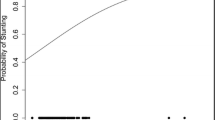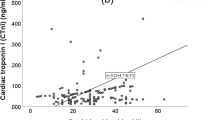Abstract
To investigate a potential relationship between an elevated lead burden and sudden infant death (SID), the lead concentrations (Pb-B) were determined in 41 blood samples from SID babies and compared with the Pb-B of 5 babies who died traumatically and 77 living control babies. Several factors that may influence the Pb-B were taken into consideration, especially a dependence of the Pb-B on age and social class. Moreover, a post-mortem water shift occurs in the blood. Even taking these factors into consideration the distribution of the Pb-B's of the SID group was found to differ on a highly significant level (>99.9%) from the control group. Five Pb-B's of the SID group were higher than the highest lead concentration found in blood from the control babies. Negative influences of lead on the pre-and postnatal maturation of the brain are discussed in the search for a possible causal connection between an elevated lead burden and the occurrence of SID.
Similar content being viewed by others
Abbreviations
- SID:
-
sudden infant death
- Pb-B:
-
blood lead concentration
References
Annest JL (1983) Trends in the blood lead levels of the US population, the second national health and nutrition survey (NHANES II) 1976–1980. In: Rutter M, Jones RR (eds) Lead versus health. Wiley, London
Aronow WS (1978) Effect of ambient level of carbon monoxide in cardiopulmonary disease. Chest 74:1
Beal SM (1983) Some epidemiological factors about sudden infant death syndrome (SIDS) in South Australia. In: Tildon JT, Roeder LM, Steinschneider A (eds) Sudden infant death syndrome. Proceedings of the 1982 International Research Conference on the Sudden Infant Death Syndrome, Baltimore. Academic Press, New York London, p 15
Bellinger D, Leviton LA, Waternaux C, Needleman H, Rabinowitz M (1985) A longitudinal study of the developmental toxicity of low-level lead exposure in the prenatal and early postnatal periods. In: Lekkas TD (ed) International Conference on Heavy Metals in the Environment, vol 1. CEP Consultants, Edinburgh, pp 32–34
Biering-Sörensen F, Jorgensen T, Hilden J (1978) Sudden infant death in Copenhagen 1956–71. I. Infant feeding. Acta Paediatr Scand 62:129–135
Biering-Sörensen F, Jorgensen T, Hilden J (1979) Sudden infant death in Copenhagen 1956–71. II. Social factors and morbidity. Acta Paediatr Scand 68:1–9
Bonser RS, Knight BH, West RR (1978) Sudden infant death syndrome in Cardiff, association with epidemic influenza and with temperature 1955–1974. Int J Epidemiol 7:335–342
Brettel HF (1972) Blutalkohol und Blutwassergehalt, Methodik Theorie Praxis. (Arbeitsmethoden der medizinischen und naturwissenschaftlichen Kriminalistik, vol 11) Schmidt-Römhild, Lübeck, p 66
Carpenter RG, Gardner A, McWeeny PM, Emery JL (1977) Multistage scoring-system for identifying infants at risk of unexpected death. Arch Dis Child 52:606–612
Coe JI, Hartmann EE (1960) Sudden unexpected death in infancy. J Pediatr 56:786–794
DFG (Deutsche Forschungsgemeinschaft) (1984) Rückstände und Verunreinigungen in Frauenmilch, Mitteilung XII der Kommission zur Prüfung von Rückständen in Lebensmitteln. Verlag Chemie, Weinheim
Dittmann V, Pribilla O (1983) Zur Epidemiologie des plötzlichen Säuglingstodes (Sudden infant death syndrom, SIDS) im Lübecker Raum, Katamnestische Untersuchungen and 155 von 1971 bis 1981 beobachteten Fällen. Z Rechtsmed 90:277–292
Ehrlich R (1966) Effect of nitrogen dioxide on respiratory infection. Bacteriol Rev 30:604–612
Erickson MM, Poklis A, Gantner GE, Dickinson AW, Hillman LS (1983) Tissue mineral levels in victims of sudden infant death syndrome. I. Toxic metals — lead and cadmium. Pediatr Res 17: 779–784
Ernhart CB, Wolf AW, Kennard MJ, Filipovich HF, Sokol RJ, Erhard P (1985) Intrauterine lead exposure and the status of the neonate. In: Lekkas TD (ed) International Conference on Heavy Metals in the Environment, vol 1. CEP Consultants, Edinburgh, p 35–37
Froggatt P, Lynas MA, Marshall TK (1968) Sudden death in babies: epidemiology. Am J Cardiol 22:457–471
Froggatt P, Lynas MA, Marshall TK (1971) Sudden unexpected death in infants (cot death) report of a collaborative study in Northern Ireland. Ulster Med J 40:116–132
Goldstein IF (1982) Seasonal relationship of sudden infant death syndrome and environmental pollutants. Am J Epidemiol 116: 189–192
Graziano JH, Popovac D, Murphy MJ, Colakovic B, Stein Z, Mehmeti A, Kline J, Ahmedi G, Rajovic B, Gasi E, Haxhiu R, Radovic L, Hoxha I, Zvicer Z, Popovac R, Bozovic R, Shrout P, LoIacono N (1985) Environmental lead and pregnancy outcome. In: Lekkas TD (ed) International Conference on Heavy Metals in the Environment, vol 1. CEP Consultants, Edinburgh, pp 414–416
Greenberg MA, Nelson KE, Carnow BW (1973) A study of the relationship between sudden infant death syndrome and environmental factors. Am J Epidemiol 98:412–422
Grüner O (1967) Der gerichtsmedizinische Alkoholnachweis, 2nd edn. Heymanns, Köln Berlin Bonn München, p 65
Henschler D (1982) Analysen in biologischem Material. Verlag Chemie, Weinheim
Hoppenbrouwers T, Calub M, Arakawa K, Hodgman JE (1981) Seasonal relationship of sudden infant death syndrome and environmental pollutants. Am J Epidemiol 113:623–635
Houstek J (1970) Sudden infant death syndrome in Czechoslovakia: epidemiologic aspects. Proceedings of the 2nd International Conference of Causes of Sudden Death in Infants, Seattle. University Press, Washington, p 55
Iyengar GV (1985) Concentrations of 15 trace elements in some selected adult human tissues and body fluids of clinical interest from several countries: results from a pilot study for the establishment of reference values. Berichte der Kernforschungsanlage Jülich, Nr 1974
Käferstein F, Müller J (1981) Heavy metals in the infant diet. ZEBS-Bericht 1/1981. Reimer, Berlin
Kinney HC, Burger PC, Harrell FE (1983) “Reactive gliosis” in the medulla oblongata of victims of the sudden infant death syndrome. Pediatrics 72:181–196
Kraus JF, Franti CE, Borhani NO (1972) Discriminatory risk factors in post-neonatal sudden unexplained death. Am J Epidemiol 96:328–333
Lewin L (1922) Die Fruchtabtreibung durch Gifte und andere Mittel, 3rd edn. Springer, Berlin, pp 280–289
Lochner C (1987) Bleibelastung und plötzlicher Kindstod —Blutuntersuchungen zur Frage eines möglichen Zusammenhanges. Dissertation, Universität München
Longo LD (1977) The biological effects of carbon monoxide on the pregnant woman, fetus, and newborn infant. Am J Obstet Gynecol 129:69–77
Merck E (1970) Klinisches Labor, 11th edn. Merck, Darmstadt
Merian E (1984) Metalle in der Umwelt. Verlag Chemie, Weinheim
McWeeny PM, Emery JL (1975) Unexpected postneonatal deaths (cot deaths) due to recognizable disease. Arch Dis Child 50:191–196
Naeye RL (1983) Origins of the sudden infant death syndrome. In: Tildon JT, Roeder LM, Steinschneider A (eds) Sudden infant death syndrome. Proceedings of the 1982 International Research Conference on the Sudden Infant Death Syndrome, Baltimore. Academic Press, New York London, pp 77–84
Ong CN, Lee WR (1980) High affinity of lead for fetal hemoglobin. Br J Ind Med 37:292–298
Piasek M, Kostial K (1985) Duration of exposure to lead and reproductive performance in rats. In: Lekkas TD (ed) International Conference on Heavy Metals in the Environment, vol 1. CEP Consultants, Edinburgh, p 463–465
Read A, Stanley F (1983) Postneonatal mortality in Western Australia 1970–1978. Aust Pediatr J 19:18–26
Rom WN (1976) Effects of lead on the female and reproduction: a review. Mt Sinai J Med 43:542
Sachs L (1984) Angewandte Statistik, Anwendung statistischer Methoden, 6th edn. Springer, Berlin Heidelberg New York
Schmidt C, Spann W, Eisenmenger W (1984) Das Phänomen des “plötzlichen Kindstodes” aus sozialer und psychologischer Sicht. Münch Med Wochenschr 126:795
Spiers PS, Wang L (1976) Short pregnancy interval, low birth-weight and the sudden infant death syndrome. Am J Epidemiol 104:15–21
Standfast SJ, Jereb S, Janerich DT (1979) The epidemiology of sudden infant death in upstate New York. J Am Med Wom Assoc 241:1121–1124
Standfast SJ, Jereb S, Janerich DT (1980) The epidemiology of sudden infant death in upstate New York. II. Birth characteristics. Am J Public Health 70:1061–1067
Stark RE, Nathanson SN (1975) Unusual features of cry in an infant dying suddenly and unexpectedly. In: Bosma JF, Showacre J (eds) Development of upper respiratory anatomy and function: implications for sudden infant death syndrome. Government Printing Office. Washington, DC, p 233
Steele R, Langworth JT (1966) The relationship of antenatal and postnatal factors to sudden unexpected death in infancy. Can Med Ass J 94:1165–1171
Stephens RJ, Freeman G, Crane SC (1971) Ultrastructural changes in the terminale bronchiole of the rat during continuous, low-level exposure to nitrogen dioxide. Exp Mol Pathol 14:1–14
Stoeppler M, Mohl C, Ostapczuk P, Goedde M, Roth M, Waidmann E (1984) Rapid and reliable determination of elevated blood lead levels. Fresenius Z Anal Chem 317:486–490
Valdes-Dapena MA (1977) Sudden unexplained infant death, 1970 through 1975: an evolution in understanding. Pathol Annu 12:117–145
Valdes-Dapena MA (1980) Sudden infant death syndrome: a review of the medical literature 1974–1979. Pediatrics 66:597–614
Weigert M (1987) Bestimmung der Bleikonzentration in Leichenblut. Dissertation, Universität München
Wide M (1983) Lead and development of the early embryo. In: Clarkson T, Nordberg G, Sagar P (eds) Reproductive and developmental toxicology of metals. Plenum, New York, pp 343–355
Wilske J (1984) Der plötzliche Säuglingstod, Morphologische Abgrenzung, Pathomechanismus und Folgerungen für die Praxis. Springer, Berlin Heidelberg New York
Winneke G, Beginn U, Ewert T, Havestadt C, Kraemer U, Krause C, Thron HL, Wagner HM (1985) Comparing the effects of perinatal and later childhood lead exposure on neuropsychological outcome. Environ Res 38:155–167
Yount JE, Flanagan WJ, Dingley EF (1979) Evidence of an exponentially increasing evidence of sudden infant death syndrome (SIDS) with decreasing birthweight (BW). Pediatr Res 13:510–517
Author information
Authors and Affiliations
Rights and permissions
About this article
Cite this article
Drasch, G.A., Kretschmer, E. & Lochner, C. Lead and sudden infant death. Eur J Pediatr 147, 79–84 (1988). https://doi.org/10.1007/BF00442618
Received:
Accepted:
Issue Date:
DOI: https://doi.org/10.1007/BF00442618




